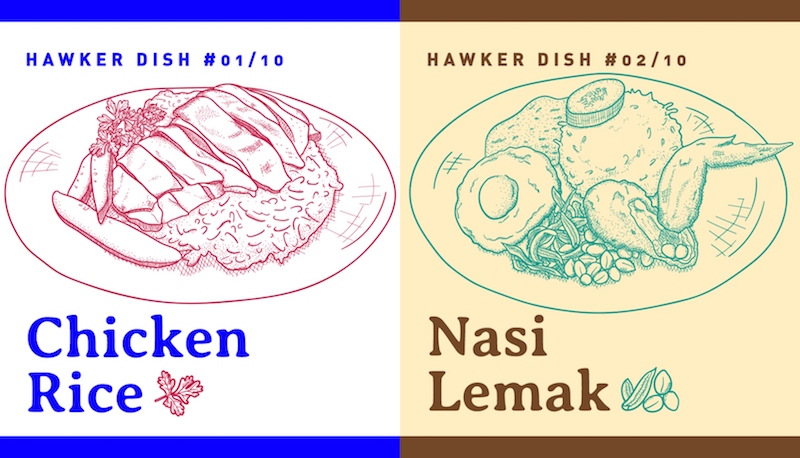Hawker culture is something that unites Singaporeans — so much so that we want to be recognized on UNESCO’s Intangible Cultural Heritage list for our devotion to our favorite affordable eats. The dishes most commonly found at hawker centres are what get us out of bed every morning, or spur us on to get work done so we can beat the lunchtime queue at famous stalls near our offices.
That’s why we’ve got countless tributes to this facet of our national pasttime — from tidbits with local flavors to accessories in the shape of kopi cups.
The latest one comes courtesy of homegrown UX and graphic designer Teo Yu Siang, who’s been working on his Hawker Heritage project for the past couple months. It’s essentially an exploration of the diverse histories of 10 iconic local dishes, all of which are digitally hand-drawn and illustrated by him.
“Hawker food feels like home. The entire experience is unlike any other elsewhere — kopitiams, Singlish, affordable prices and amazing food,” he tells Coconuts Singapore. “To me, hawker food is the background around which we grow. Much like the buildings around us, they influence us indirectly.”
Each week, two familiar items are surfaced, along with a deep dive into their origin stories. So far, the likes of nasi lemak, chicken rice, rojak, wanton mee, and putu piring/kueh tutu have been highlighted, with more to come.
Below, Teo shares more about his concept and why hawker food means so much to him.
How did you come with the concept for this project?
I’ve always had a fondness for local hawker food, and this year there has been a certain buzz around it, what with Singapore’s bid for hawker culture to be recognized as a UNESCO intangible cultural heritage. However, what sparked this project for me was when my colleague from London came to Singapore and I showed her around the country.
I brought her around to try various local food—from kaya toast and kopi to chicken rice and satay—and with every dish we ordered, I gave a brief explainer of the dish. It was then that it struck me that hawker food represents a unique and seamless blend of cultures, so much so that you can’t really tell where one culture ends and another begins. Just the name “kopi peng” is a blend of Malay and Hokkien, for instance.
Why the focus on hawker food?
First, it’s the one thing Singaporeans (almost) unanimously love. We argue about policies, we debate about LGBTQ and gender equality, but the one thing that we all agree on is that our hawker food is just one of the best in the world. It’s thus a common ground — something all Singaporeans love or, at the very least, are exposed to every day.
Next, hawker food represents diversity — perhaps more than we think. We can trace many of our iconic dishes to every corner of the globe — chicken rice came from Hainan, China; putu piring from Kerala, India; even the peanuts used in rojak can be traced all the way to Mexico. These different backgrounds came to Singapore through popular influence and colonial forces — but for some reason, they blended together rather than clashed. We’ve learnt to mix the best of all worlds to create truly local dishes.
How did you narrow it down to these 10 in particular?
I decided on 10 dishes mostly out of practical reasons. It takes quite a long time to research, illustrate and code each hawker dish — one dish takes around 2-4 hours just to illustrate.
I chose the 10 dishes that I felt represented a wide range of cultural influences — so, for example, there should be some Chinese, Malay, Indian, Peranakan, etc. dishes. I also chose hawker dishes that had interesting stories or etymological backgrounds. For instance, “wanton mee” might not have an exciting background story, but I liked how its name is a blend of Cantonese (wanton) and Hokkien (mee), which is something most locals probably won’t even realize.
Why do you think hawker food is such a big part of being Singaporean?
I think at a fundamental level, hawker food is the only financially feasible option to eat out in an expensive city like Singapore. And the reality is that many low income locals depend on low cost hawker food to make ends meet.
But beyond that, the huge variety of hawker food is what I think draws many Singaporeans to hawker food. It’s also a multicultural experience: you get your meal from one stall out of 100 others in a hawker centre, order in Singlish, get your amazing food within minutes, and bring it back to a table you’ve “choped” with a packet of tissues.





Reader Interactions